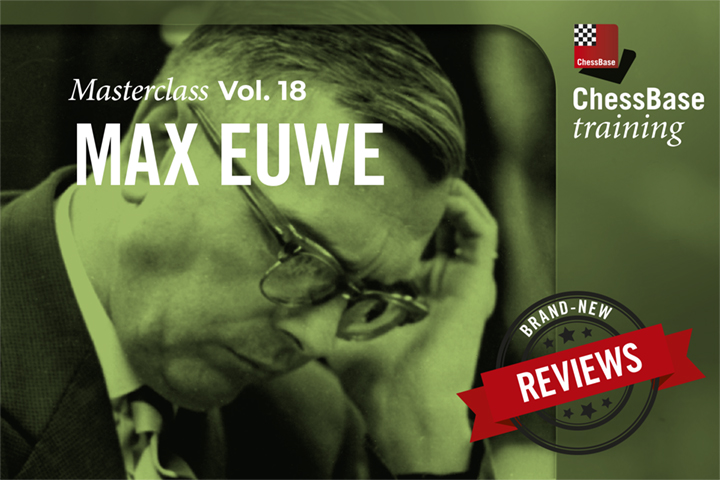Max Euwe – An Underrated World Champion
In Volume 18 of the Master Class series, a team of ChessBase experts turns its attention to a chess personality who is certainly underrated today: the fifth World Champion, Max Euwe. Born in 1901, the Dutchman defeated Alexander Alekhine in a 30-game World Championship match in 1935, a feat that demonstrates the level of his play at the time. He held the world title until 1937, when he lost the rematch against Alekhine. Beyond the chessboard, Max Euwe also enjoyed a successful academic and professional career as a mathematician, teacher, and university professor.
Max Euwe became the fifth World Chess Champion after beating Alexander Alekhine in the 1935 World Championship match. A maths teacher by profession, Euwe remained an amateur throughout his life, but was still the best chess player in the Netherlands, and one of the world’s best players. Euwe holds the record for the most Dutch national championships, with twelve. After winning the World Championship, Euwe was also the world’s best player for a while. He lost the title again in 1937 in the rematch against Alexander Alekhine.
Free video sample: Openings
The Master Class begins with Euwe’s contributions to opening theory, illustrated through several instructive examples by Grandmaster Dorian Rogozenco.
With the black pieces, Euwe demonstrated outstanding dynamic understanding in the King’s Indian Defense—at a time when the opening was still considered only semi-sound. As is typical of great minds, he followed his own ideas.
Tarrasch–Euwe, Amsterdam 1923
9…h6 10.Qd2 Kh7 11.g4 Nf6
Euwe had a fondness for the maneuver beginning with …h6. Modern engines strongly dislike this move in this position, but in his game against Tarrasch, the Dutchman managed to keep the kingside closed and later broke through on the opposite flank.
Euwe also recognized the potential of the Scheveningen Variation of the Sicilian, named after the Dutch seaside town, decades before it became truly popular. In his World Championship matches against Alekhine, the Slav Defense also played a central role, with lines being developed that remain popular to this day.
In the strategy section of the Master Class, Grandmaster Mihail Marin highlights the strategic strengths of Max Euwe’s play. One of the Dutchman’s trademarks was his preference for positional sacrifices, which he sometimes deliberately provoked:
Alekhine–Euwe, Match 1926

36…Kh8!?
Euwe voluntarily moves his king onto the open file! But isn’t 37.Bh4 strong now, because after 37…Qxh4 there follows 38.Rh2, and otherwise 38.Bf6 would come? In fact, Alekhine did play 37.Bh4, but he probably shouldn’t have…
Tactics and attacking training with Max Euwe
This was my first volume from the Master Class series, and I have to say that the tactics section by IM Oliver Reeh was the highlight of the course for me! In a move-by-move format, the viewer takes the role of the powerful calculator Max Euwe. In the 21 game fragments presented, there is often not just a single tactic to find, but in many cases a full attacking sequence, move by move, all the way to the combinational finish. After each move, the Hamburg-based IM provides feedback—both on the correct solutions and on plausible but incorrect choices.
Learn from legends! Get the full Master Class series on the World Champions at a discounted bundle price – only for a limited time.
Learn from legends! Get the full Master Class series on the World Champions at a discounted bundle price – only for a limited time.
My recommendation here is not to play the first move that comes to mind after a quick glance at the position. Instead, take the time to truly understand the situation on the board. That might mean spending up to 15 minutes on a single position. In this way, Oliver Reeh’s tactics section offers enough material for multiple training sessions aimed at improving your attacking and tactical skills.
Euwe–Loman, Scheveningen 1922

Oliver Reeh gave the following attack the motto “The Art of Pawn Play.” In fact, the next five moves played by White are all pawn moves. Which one could be the first?
The final chapter on endgames is presented by renowned Hamburg expert GM Karsten Müller, who takes a detailed look at ten instructive endgames played by the fifth World Champion. Among them are several impressive highlights, including games against Capablanca and Alekhine—such as the famous “Pearl of Zandvoort.” But I also particularly enjoyed the following transformation against a lesser-known opponent:
Euwe–Landau, Amsterdam 1938

Good knight vs. bad bishop?
Yes, but after 32.Nxe6+! Rxe6 33.f5, White reaches a much more favorable double-rook endgame!
On this DVD GMs Rogozenco, Marin, Müller, and IM Reeh present outstanding games, stunning combinations and exemplary endgames by Alekhine. And they invite you to improve your knowledge with the help of video lectures, annotated games and interactive tests
Conclusion
With a total running time of nearly eight hours, viewers can immerse themselves in the decades-long career of the fifth World Chess Champion, Max Euwe. This new Master Class is an important contribution, as very few people today know much about Max Euwe. Four experts present instructive examples across the areas of opening, strategy, tactics, and endgame. It’s an engaging experience overall, with the tactics chapter (focused on attacking play) standing out as especially well-suited for training—since viewers are invited to take the role of the World Champion themselves.
